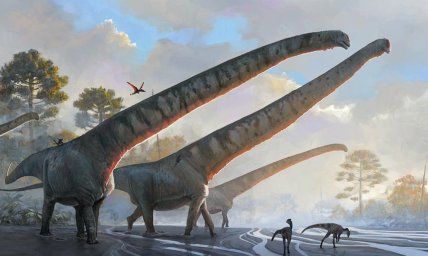How the extinction of dinosaurs paved the way for human emergence: scientists highlight an unexpected connection.
Evolution is an incredibly complex phenomenon with a vast array of interdependent factors, and altering some of these can lead to unforeseen consequences in the future. For instance, the asteroid impact around 66 million years ago not only wiped out a significant portion of the dinosaurs but also created conditions conducive to the evolution of humans.
At first glance, causal relationships may seem obscure, but researchers from Northern Arizona University (USA) have uncovered them. The study was published in the journal Palaeontology on February 17, 2025.
Long-necked sauropods are undoubtedly among the most famous dinosaurs in popular culture. It can be confidently said that they played a crucial role in the existence of our planet during their lifetime. Their massive size allowed them to break trees and consume vast amounts of vegetation, effectively creating new ecosystems.

Dense vegetation poses a challenge for other plants that are just beginning to reach for the sun. Thus, the presence of large herbivores alleviated the evolutionary pressure on young plants, enabling them to grow under more "comfortable conditions."
However, when the asteroid struck, the sauropods became a thing of the past, and the forests were left "unattended" for millions of years. This meant that they evolved according to new conditions, becoming denser and reducing the amount of light that could reach the understory.
For mature trees, this is not an issue, but the survival chances for young shoots significantly decreased. In these new conditions, only those plants with the largest seeds could compete for sunlight. This trend is precisely what the scientists highlight in their new research.
It seems that the extinction of the dinosaurs triggered an increase in seed size among plants, allowing them to store more nutrients. Ultimately, this led to a significant rise in the prevalence of fruit-bearing trees, which became a primary food source for many early mammals, including the ancestors of primates.
The researchers developed a model demonstrating that plant seeds increased in size from 66 million years ago until about 35 million years ago, after which they began to decrease slightly. They associate this with the emergence of new large herbivores that started to fell trees again, reinstating the advantage for plants with smaller seeds that require less time to develop and germinate.

In the last 50,000 years, the world has lost a significant portion of its large herbivores, leading to an increase in forest density. According to the model, seeds should become larger again; however, human activity may likely hinder this process.
Regardless, the new research leads to the conclusion that our very existence is linked to a tragic event that occurred at the boundary of the Cretaceous and Paleogene periods. It also prompts reflection on how uncontrolled deforestation will affect the world's development over the next millions of years.
As previously reported, scientists recently announced that they have discovered actual dinosaur protein. Typically, organic material does not survive for such extended periods, making this find potentially sensational.